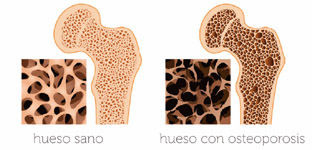What is osteoporosis and why does it happen?
Osteoporosis is a disease of the bones characterized by a loss of bone mass and a reduction in the quality of bone mass, which lead to an increase in the fragility of the bones and increased risk of fracture. Osteoporosis is a result of an imbalance between the formation and the destruction of bone mass.

What are its symptoms?
Osteoporosis is asymptomatic, i.e., it does not cause pain unless the bone is fractured. So fractures can appear anywhere, although they are most common in the hip, wrist, spine, arm, ribs and pelvis. Fractures, particularly in the hip and spine, become evident mainly in that there is a loss in quality of life –often taking the form of the patient becoming dependent for many day-to-day activities – pain, deformities, affectation of the patient’s energy and self-esteem and the high social-economic cost involved.
Who is affected by osteoporosis and what are the risk factors?
Osteoporosis can affect both sexes, although it is more common in women. So, the fact that most people affected are women going through the menopause, which is due to the reduction in estrogen levels that happens during this, makes it one of the main risk factors. Furthermore, there are other risk factors that may contribute to the development of the condition like: the consumption of alcohol, smoking, family history of osteoporosis, lack of calcium and vitamin D rich foods, some diseases (endocrinological, neurological, lung, digestive, etc.) and some drugs affecting calcium levels in the bone (anticonvulsants, corticosteroids, heparin, antidiabetics, etc.) among others.
How can it be prevented?
During the first decades of life, particularly during puberty, the bones reach their maximum level of development, known as “bone mass peak”, which constitutes the moment from which there is a progressive loss of bone mass, from the third decade of life. For that reason, to prevent the development of osteoporosis, a series of recommendations should be followed many years before the typical signs of the disease appear. Prevention consists of leading a healthy lifestyle, which includes regular exercise, not smoking, drinking alcohol in moderate quantities and following a balanced diet.

Furthermore, there is a series of factors that should be taken into consideration to look after one’s bone mass:
- Have the right intake of calcium.Consume enough dairy and calcium rich produce.
- Keep up one’s level of vitamin D by consuming vitamin-D-rich foods and having sufficient exposure to sunlight.
- Do regular exercise apt for one’s age.One of the most recommended exercises is walking on the flat.
- Avoid risk factors associated with falls to thus prevent fractures.Remove obstacles in the home or workplace, install good lighting, wear glasses and/or use a walking stick if necessary, wear adequate footwear, etc.
How can it be diagnosed?
The diagnosis of osteoporosis is done taking into account the personal and family history of the patient, an integral physical examination and some laboratory and image diagnosis tests that vary for every patient. We currently use a series of clinical scales and image tests that help to determine the individual risk each patient has of suffering a fracture.Thus, one of the most effective tests to do this is the bone densitometry test. Bone densitometry is one of the most common aids in the diagnosis of the condition. At its various centers, the Hospiten Group has at its disposal state-of-the-art technology to do the job. The equipment carries out a radiographic examination enabling doctors to see the exact state of the patient’s bones to a high degree of precision. The examination is painless, as it is a non-invasive procedure similar to that done for other radiological examinations.
Who should have a Bone Densitometry Test?
- Women over 65 years of age.
- Women going through the menopause or who are post-menopausal at younger ages to those associated with risk factors.
- Patients with a personal or family history with osteoporosis risk factors.
- Patients being treated long term with corticosteroids or any other medication that may cause a loss of bone mass.
- Women suffering from early estrogen deficiency (under 45 years of age), as they may benefit from starting treatment.
- Patients previously diagnosed and in treatment for osteoporosis, as a means of controlling the effectiveness of the condition.
What does treatment consist of?
The best treatment is always prevention and therefore, it is important to acquire healthy lifestyle habits to prevent the condition developing. Moreover, the results of current treatments for osteoporosis are better the sooner the diagnosis is made and the sooner treatment is started. That is why early detection of the disease enables us to maintain a good quality of life by reducing the risk of fractures and their consequences. In spite of the fact that there is currently no cure for the disease, there are alternative therapies that help slow down its progression and relieve the consequences, thus achieving the best possible welfare for those affected.
Recently, a new treatment has been incorporated to the battery of therapies for osteoporosis, so there are a variety of treatment options and form (oral, intravenous and subcutaneous) and frequency of administration (daily, weekly, monthly, six-monthly and yearly). In any case, it is the physician, in consensus with the patient, who decides on the type of drug or the most appropriate procedure depending on each specific diagnosis.